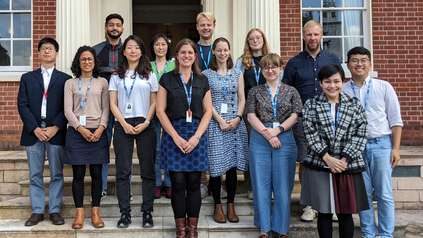'Gene misbehaviour' widespread in healthy population
Listen to “'Gene misbehaviour' widespread in healthy population” on Spreaker.
Scientists have uncovered that ‘gene misbehaviour’ – where genes are active when they were expected to be switched off – is a surprisingly common phenomenon in the healthy human population.
The team also identify several mechanisms behind these gene activity errors. This may help inform precision medicine approaches and enable the development of targeted therapies to correct expression.
Researchers from the Wellcome Sanger Institute, the University of Cambridge and AstraZeneca studied the activity of inactive genes in a large, healthy population for the first time. While rare at the individual gene level, they revealed misexpression is widespread across samples and involved more than half of the genes that should be inactive.
The findings, published today (24 July) in the American Journal of Human Genetics, shed new light on how our genetic code operates. The approach could be used in future research to investigate various complex diseases.
The human genome contains about 19,900 genes. These genes form part of the instruction manual for our bodies, encoding proteins needed to carry out cell functions. Proper gene regulation involves turning these gene instructions on and off as needed, depending on a cell’s specific role or environmental factors. When this regulation fails and a typically inactive gene is activated, or ‘expressed’, it can disrupt normal cell function1.
While gene misexpression has previously been linked to several rare diseases, such as congenital limb syndromes2, it is not known how often or why this may happen in the general population.
In this new study, researchers analysed blood samples from 4,568 healthy individuals from the INTERVAL study3. They used advanced RNA sequencing techniques to measure gene activity and whole genome sequencing to identify genetic changes behind irregular gene activity.
The team found that while misexpression events were rare at the individual gene level –occurring in only 0.07 per cent of genes – nearly all samples – 96 per cent – had some misexpression, with over half of the normally inactive genes showing misexpression. They also found these events can be caused by rare structural changes in the DNA4.
While these findings show that gene misbehaviour is common, it may not always lead to health issues. This new understanding of the prevalence and mechanisms of gene misexpression provides a valuable tool for further investigation into the complexities of human genetics and disease. This could help in diagnosing and developing treatments for conditions caused by misexpression.
“Until now, we have been looking at disease risk through the lens of highly active genes. Our study reveals ‘unusual’ gene activity is far more usual than previously thought and we need to consider the full picture, including genes that shouldn’t be active but sometimes are. This is a big step towards more personalised healthcare, enabling a more comprehensive understanding of all the ways our genes impact our health.”
Thomas Vanderstichele, first author of the study at the Wellcome Sanger Institute
“Interestingly, while over half of genes occasionally misexpress, we find certain critical genes, particularly those governing development, rarely make such mistakes. This suggests that when these essential genes do misexpress, the consequences for health and disease are likely to be more severe.”
Dr Katie Burnham, author of the study at the Wellcome Sanger Institute
“The work of this pioneering large-scale study is testament to the incredible ‘genomics ecosystem’ in Cambridge that brought together experts from the Sanger Institute, the University of Cambridge and AstraZeneca. The findings open avenues for research into gene misexpression across different tissues, to understand its role in various diseases and potential treatments.”
Dr Emma Davenport, senior author of the study at the Wellcome Sanger Institute
More information
References:
- Gene misexpression can involve a single inactive gene – non-chimeric – or a new gene product made from parts of different genes – chimeric.
- D.G. Lupiáñez et al. (2015) ‘Disruptions of Topological Chromatin Domains Cause Pathogenic Rewiring of Gene-Enhancer Interactions.’ Cell. DOI: 10.1016/j.cell.2015.04.004
- The INTERVAL trial was a randomised trial of 50,000 participants assessing how often blood donors can safely give whole blood, in which participants also consented to be part of a bio-resource enabling a broad range of health-related research. For more information on the INTERVAL study, please access: https://www.sanger.ac.uk/collaboration/interval/
- They identified mechanisms that can cause misexpression such as the gene reading beyond its usual endpoint (transcriptional readthrough), combining parts of different genes (transcript fusions), and flipping genes around (gene inversion).
To access these data, please refer to the publication.
Publication:
T. Vanderstichele et al. (2024) ‘Misexpression of inactive genes in whole blood is associated with nearby rare structural variants.’ American Journal of Human Genetics. DOI: 10.1016/j.ajhg.2024.06.017
Funding:
This research was supported by Wellcome, UK Research and Innovation (UKRI) and AstraZeneca. For full funding acknowledgements, please refer to the publication.




